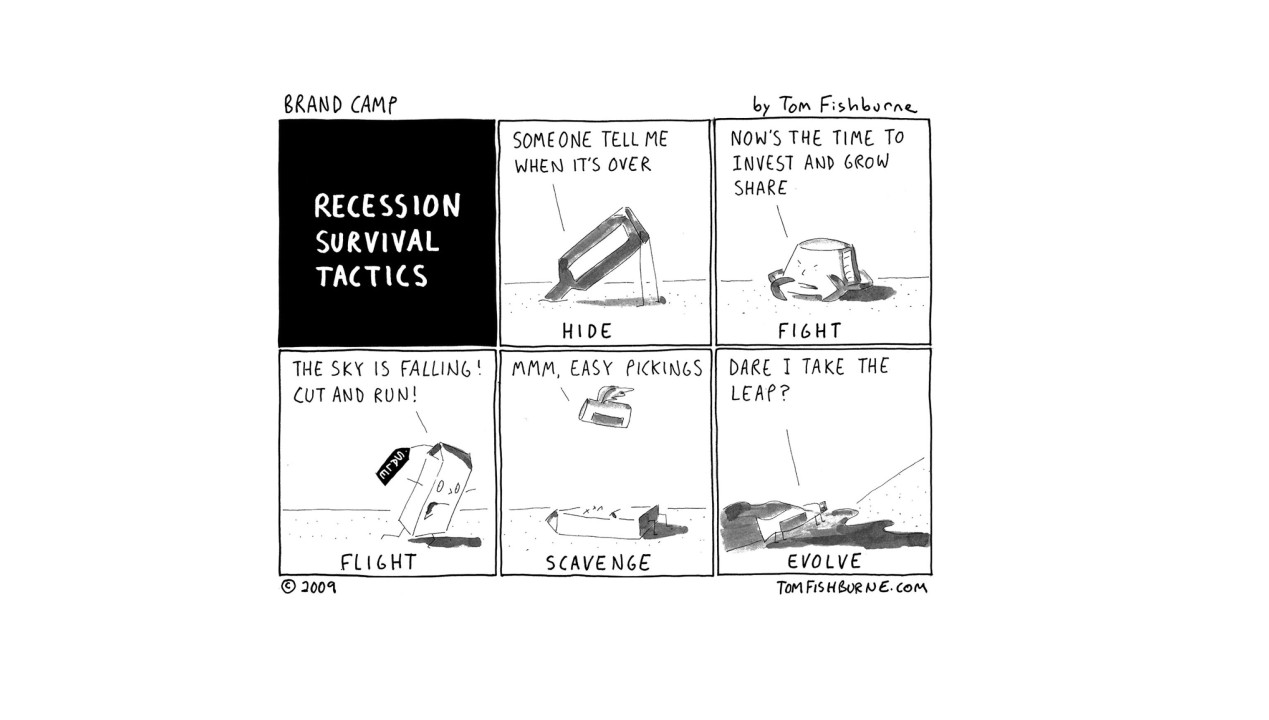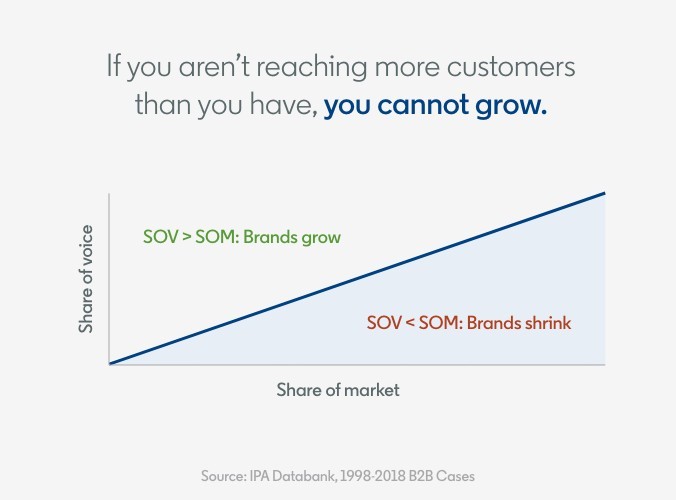
Keep calm and keep growing: How to build marketing pipeline in a downturn
It’s no secret that the current economy is tough.
For B2B marketers, growing uncertainty and tight budgets make it harder to build brands, generate leads, and hit targets for marketing sourced pipeline.
Don’t worry though, there are still plenty of ways to grow without breaking the bank.
We learnt from the recessions of 1980, 1990, and 2000 – that there are both winners and losers for every cycle. While many struggled, 9% of companies flourished, outperforming competitors in sales and profit growth.
What did they do right?
Let’s look at 3 steps (thanks Bain & Co and The B2B Institute) to building marketing sourced pipeline in a downturn.
Let’s sit back, relax, and beat the recession! 😉
1. Take a fresh look at revenue
When the global economy shifts, so do the pieces on the chess board♟
For every recession, there are both opportunities and challenges, and companies need solutions to new challenges. These shifts will have prospects moving either towards or away from you, so the first step is to understand which direction they’re moving in. Then it’s about mapping the opportunity (or controlling the damage).
Whether you focus on upside or downside will depend on which category you find your customer or prospect in:
- Surge 💹
- Secure 🔐
- At-risk ❗
- Unknown 🔍
The first three of these will become custom audiences for your marketing campaigns. So let’s have a closer look at what each stage is about.
Surge 💹
What does it mean that economic shifts have a way of shaking the board?
When your potential customers are using incumbents, they usually find it hard to change. That’s why many have been putting off that supplier change. But recessions are a catalyst for this change.
Incumbents usually charge higher prices and provide less bespoke options, so when procurement puts pressure buyers to review more valuable options, your have your in.
Broadly speaking, pressure is on to grow revenue or cut costs. So whether your product is a growth driver or a cost saver, this will be attractive to your potential customers looking for a long term solution, while also being sensitive to the next 60, 90, or 120 days.
- If your product is an investment, messaging can emphasize the new areas of growth you will unlock for them.
- If your product is a cost saving, or increases productivity (another way of saving cost), messaging can emphasize how this will impact their financial security.
Secure 🔐
Secure customers are the holy grail of a downturn.
Customer retention is a top priority at any time, and more so now. So the budget mix between acquisition and retention might need a re-balance. This is where “Acceleration & Expansion” styles of ABM come into play.
Even if your customers aren’t looking for new long term investments, they’re still looking to get the most out of existing ones. That’s why helping clients with long contractual commitments is the easiest way to win in a recession. When customers are navigating budget cuts of their own, we in marketing can create quick wins for our organizations with customer marketing campaigns.
- Share content that educates customers in getting more value out of your existing features.
- Guide them with content designed to help navigate the challenges they’re facing, especially those that fall within your area of expertise.
- Speak to your impact on their bottom line. The same lessons from Surge 💹 customers apply here! Reinforcing the financial value of your product helps motivate their long term investment.
At-risk ❗
At-risk is important because prevention is better (and cheaper) than cure.
At risk companies aren’t necessarily leaving you tomorrow, but we identify a risk because there’s nothing stopping them from doing so. That’s why it’s better to understand why they might leave, and to be pro-active in solving this.
Clients who aren’t on long term retainer contracts might not understand the benefits of working with you more closely. They might not have a fully engaged buying group who understands what you do. They might not even know why you were purchased in the first place, if champions have moved on or contract owners have changed hands.
- Treat these accounts like you’re on the first date. Build an “At-risk” shortlist to give them a targeted, personalized campaign with the most valuable content your marketing team has to offer.
- Drive surveys and consultation session to understand their challenges better. The supplier closest to the inner circle gets preference.
- Rather then losing short term contracts, it pays to be open for negotiation wherever possible.
Unknown 🔍
What we don’t know can hurt us.
The “everything else” bucket is usually filled with uncomfortable truths. If there isn’t enough information on an account to make a call, that’s a clue to look deeper. What do your account and sales teams know about this account? And how could you help?
- Treat each on a case-by-case basis. Rather than make assumptions for the entire market based on one or two customers, so it’s recommended
- Run this exercise at a practical level of detail to find patterns. You might find similar trends in customer segments, product types, geography, or industry.
Now that we can see the opportunities and challenges clearly, it’s time for a battle plan.
2. Set up a “Revenue Win Room
At the start of COVID-19 in 2020, Bain found a pattern among top 9% of outperforming companies.
During the most critical stages of uncertainty, they rallied themselves. They centralized marketing & sales teams by putting them in the same room. Digitally speaking.
By win room, we mean a versatile command center that lets executives take rapid, decisive actions..
“Revenue Win Rooms” were tasked with 3 actions
- Create an accurate map of each customer’s spend
- Find opportunities to capture this spend
- Run plays to test each opportunity
With the whole team present, sales added real-time intelligence from the field to customer maps. This allowed them to move fast as a team and shift sales and marketing resources to critical areas. A lean, mean revenue machine that could track the full extent of its efforts – what worked and what didn’t.
Agility was the magic word.
Following Agile principles, they would run daily stand-up meetings, keep the team small, and make iterative changes. This way they moved fast while the front lines remained stable.
Inside the room, there was a team was dedicated to running a ‘sales-play factory’.
The factory developed market-ready plays that tested by the rest of the team. They came up with offerings to target segments, along with the marketing, sales collateral, and training support needed to make these happen.
There were 5 main plays, applied based on what each customer map revealed.
While there’s plenty of upside in starting a revenue win room, Bain provided two cautions when running this initiative.
- Keep it simple: this keeps agility possible, and increases odds of success. Customers don’t want complex. In fact, their ability to absorb complexity goes down in stressful times.
- Make roles and accountabilities crystal clear: be a coach with your team; make sure each team member knows where to be on the field and what to do.
The past 2 years we’ve been working with our clients on ABM programs for each of these types of plays. Lessons learnt are that a highly personalized, 1-1 approach works best for existing customers. Whether you’re Upselling, Cross-selling or Renewing – existing customers expect marketing touchpoints as personal as their sales touchpoints.
But for winning new customers, the longer, broader approach still works best. Which brings us to Marketing’s secret weapon for winning in a recession.
3. Play the long and short game
Getting ahead in a recession is a game played at two frequencies.
When things go pear shaped, we tend to focus on the short term. And this makes sense. But it’s also the biggest threat to our chances of coming out the recession thriving, or merely surviving.
So what’s the difference between long and short term marketing, exactly?
- When we thing of the short game, we’re talking sales activation and campaigns that generate an immediate result (e.g. sales or sign-ups) but with effects that decay quickly. It’s common in B2B SaaS to refer to this part of the funnel as “demand capture”.
- In the long game, we’re talking brand building, that delivers modest growth in the short term but produces the biggest long-term paybacks. This is where fame and mental availability, or “share of mind” are built.
It’s just dripping with irony that the short game where we’re most likely to fall short.
In B2B, brands that set their share of voice (SOV) above their share of market (SOM) tend to grow. Those that don’t, tend to shrink. That’s why ignoring the long game can cause even more damage than the recession itself.

“Hit and run” campaigns alone aren’t enough, because they’re out of sync with how buyers research and make decisions in 2022. But when they’re combined with brand campaigns that drive excess share of voice, these outperform the competition.
So what does a balance between the two look like?
Brand activity creates demand (filling the top of the sales funnel), and activation converts that demand efficiently into revenue (the bottom of the funnel).
Businesses need both kinds of marketing activity. When the balance is right, each enhances the other.

Practically, these means setting the two up in parallel, allowing them to feed them into each other. In general we want to move from a “hit and run” model to an “always on” approach.
- While running your awareness campaigns, build retargeting audiences that can be served lower funnel content
- Use ABM data to understand which accounts need more brand exposure, and which are ready for sales activation. LinkedIn has a free ABM engagement tracker you can use by following these steps.
- Try a combination of 1st and 3rd party data intent data to build audiences for sales activation campaigns. If 6Sense tells you companies are researching the problem you solve, that’s good. If 6Sense tells you that AND you’ve seen them on your website and G2 product pages, that’s amazing.
If you’re struggling to balance the two, online community is a great place to combine long and short plays. Done well, a B2B community will grow into a haven of social proof, value-add and positive brand sentiment.
In fact, we have a space called the B2B Marketing Tribe here on LinkedIn for those grappling with growth. Come say hi and we’ll welcome you in!
So, in summary
- Take a fresh look at revenue 💰
- Set up your own “Revenue Win Room” 🤝
- Play the long and short game ♟
That just about wraps it up – good luck and all the best for Q3.

